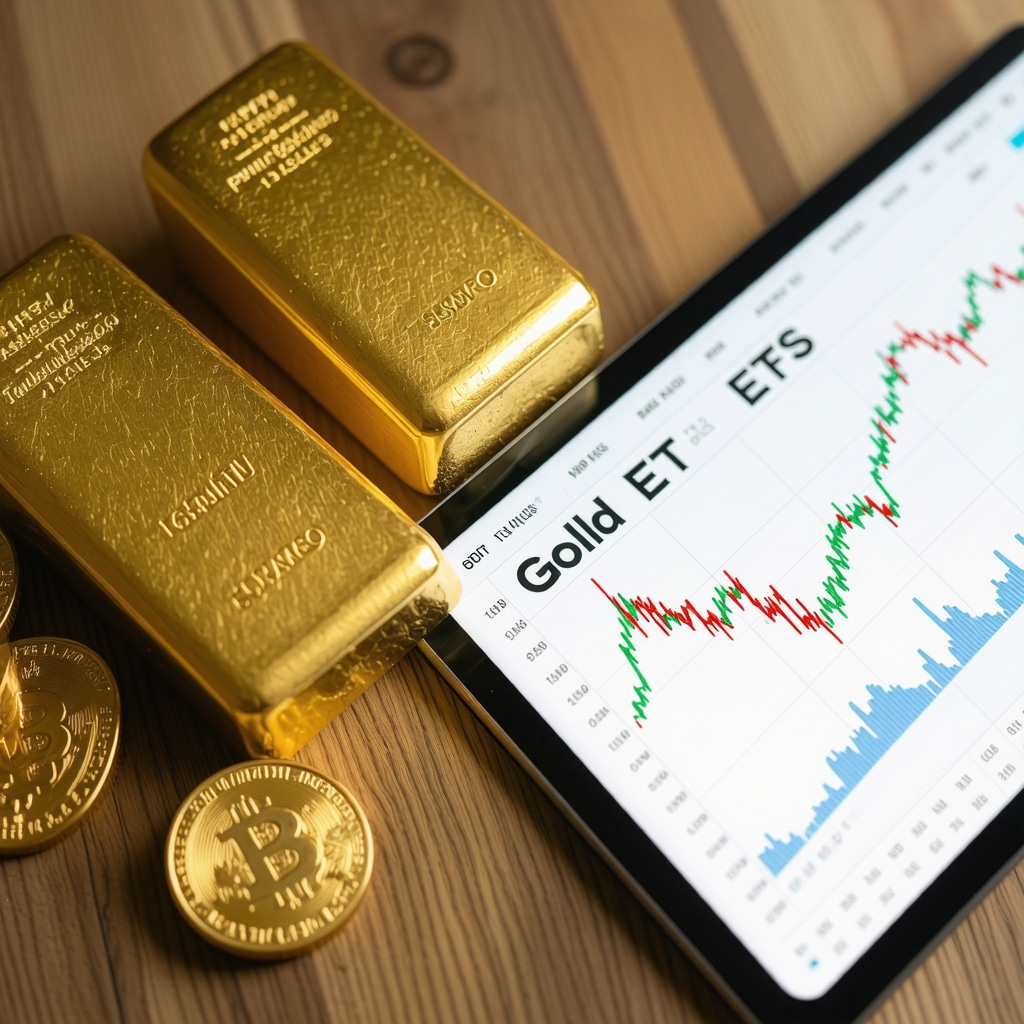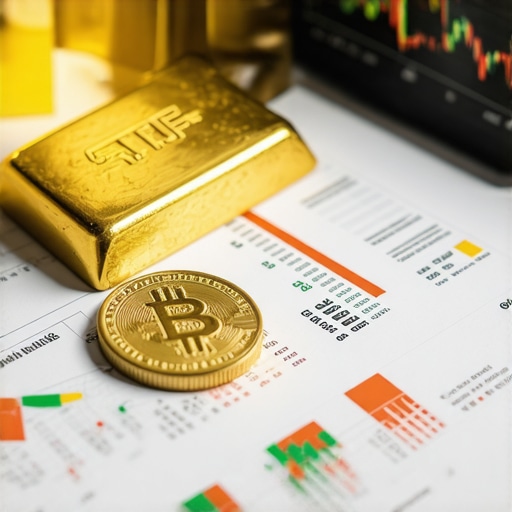Unveiling the Glitter: Why the Debate Between Physical Gold and Gold ETFs Matters
In the dynamic landscape of wealth preservation, gold has long been heralded as a bastion against inflation and market volatility. Yet, when it comes to investing in gold, the choice between tangible physical gold and the more abstract Gold Exchange-Traded Funds (ETFs) can perplex even seasoned investors. This article dives deep into the nuanced distinctions and practical considerations of Physical Gold vs Gold ETFs, empowering you to tailor your investment strategy with precision and confidence.
Touch or Trade? The Tangible Appeal of Physical Gold
Physical gold, encompassing coins, bars, and bullion, offers a visceral sense of ownership unmatched by digital alternatives. Investors who value direct possession often appreciate the intrinsic security of holding a tangible asset. For example, during episodes of financial uncertainty, physical gold can be a reliable store of value without dependency on financial institutions or digital infrastructure.
However, this palpable advantage comes with challenges: storage costs, insurance, and the risk of theft or loss. Moreover, buying physical gold demands scrutiny to avoid counterfeit products, emphasizing the importance of trusted dealers. For comprehensive guidelines on purchasing and securing physical gold, explore our detailed resource on physical gold investment tips.
Gold ETFs: The Modern Gateway to Gold Investment
Gold ETFs represent units in funds that track gold prices, traded conveniently on stock exchanges. This option appeals to investors seeking liquidity, ease of transaction, and minimal hassle of physical storage. ETFs allow fractional investment, enabling portfolio diversification without substantial capital outlay.
Yet, investors should be mindful of management fees, market risks, and the absence of physical possession. Unlike physical gold, ETFs are subject to counterparty risks and market fluctuations. For those interested in a step-by-step introduction to Gold ETFs, our guide on buying gold ETFs safely offers valuable insights.
How Do Physical Gold and Gold ETFs Compare in Terms of Liquidity and Security?
Liquidity is a pivotal factor: Gold ETFs boast superior liquidity, allowing investors to buy or sell shares instantly during market hours. Physical gold, conversely, requires finding buyers or dealers, which can delay transactions and impact pricing. From a security standpoint, physical gold protects against digital vulnerabilities but demands secure storage solutions. ETFs depend on the integrity and solvency of the fund managers and custodians, exposing investors to systemic risks in extreme market conditions.
Weighing Costs and Convenience: The Investment Balancing Act
Investing in physical gold involves upfront premiums, storage fees, and insurance costs, which can erode overall returns. Conversely, Gold ETFs impose management fees but eliminate storage concerns, providing a cost-efficient alternative for active traders or long-term holders seeking ease. The choice often boils down to individual risk tolerance, investment horizon, and financial goals.
Seasoned investors frequently adopt a hybrid approach, combining physical gold for security with Gold ETFs for liquidity and portfolio flexibility. This strategy leverages the strengths of both forms, cushioning against diverse market scenarios.
Expert Perspectives and Authoritative Insights
According to the World Gold Council, physical gold remains a critical asset class for diversification during economic turmoil, while Gold ETFs facilitate access for broader investor demographics seeking convenience and lower entry points. Their comprehensive analysis highlights that understanding gold investment demands is essential for aligning choices with personal investment profiles.
If you’re keen to explore more about building a balanced portfolio integrating Gold ETFs and other instruments, consider our article on building a balanced portfolio with Gold ETFs and mutual funds.
Investing in gold, whether physical or ETF-based, is not merely a financial decision but a strategic choice shaped by your unique needs and market understanding. Share your thoughts or experiences with gold investments in the comments below, and let’s foster a community of informed investors.
Personal Lessons on Storage and Security of Physical Gold
Reflecting on my early experiences with physical gold, I vividly recall the anxiety of finding a safe yet accessible storage solution. Initially, I tried a home safe, but the thought of a potential burglary loomed large. Insurance helped ease the fear, but it added ongoing expenses. Eventually, I opted for a bank safety deposit box, which offered better peace of mind but limited access convenience. This journey underscored how storage is not merely a logistical task but a critical part of the investment strategy itself.
It’s worth noting that secure storage is a common challenge among physical gold investors. According to the World Gold Council, a significant portion of retail physical gold is stored outside the banking system, highlighting the importance of trusted storage methods and the risks involved. This insight made me appreciate the trade-offs between physical possession and security risks more deeply.
Gold ETFs: Convenience Meets Market Exposure
On the other hand, my transition to Gold ETFs was marked by the ease of trading and no worries about physical safekeeping. The ability to buy and sell shares instantly, often at low transaction costs, felt liberating compared to the traditional hurdles. However, I quickly learned that ETFs expose investors to broader market dynamics, including the risk of fund mismanagement or liquidity crunches in extreme scenarios.
Balancing these considerations, I found that Gold ETFs are particularly suitable for those who prioritize liquidity and minimal hassle, while physical gold appeals more to those seeking tangible assets and protection against systemic financial risks. For beginners curious about starting with ETFs, I recommend checking out this step-by-step guide that makes the process approachable.
Which Investment Aligns Best with Your Financial Goals and Risk Appetite?
This question often intrigues my friends and fellow investors: Do you prefer the tactile assurance of physical gold, or the fluid, accessible nature of Gold ETFs? The answer truly depends on your individual financial goals, risk tolerance, and lifestyle. For instance, if you favor a hands-on approach and long-term wealth preservation, physical gold might be your best bet. Conversely, if you value easy portfolio diversification and quick transactions, Gold ETFs are a compelling choice.
Personally, I’ve adopted a hybrid approach, blending physical gold with ETFs to harness the strengths of both. This strategy cushions my portfolio against diverse market conditions and aligns with my evolving financial priorities. If you’re interested in constructing such a balanced setup, take a look at our article on building a balanced portfolio with Gold ETFs and mutual funds for actionable insights.
Navigating Market Volatility: My Experience with Gold Price Fluctuations
One vivid memory that stands out is during a period of heightened geopolitical tensions when gold prices surged dramatically. Holding physical gold brought a unique sense of security, knowing I had a real asset in hand amid market chaos. However, I also noticed that the liquidity of Gold ETFs allowed me to capitalize on short-term price movements, which wouldn’t have been possible with my physical holdings.
This experience highlighted how understanding gold price forecasts and market trends can empower investors to time their moves more strategically. It also reinforced the value of integrating both physical and ETF gold investments to enhance flexibility and security.
Have you ever faced a similar dilemma between holding physical gold or trading ETFs during volatile markets? Feel free to share your stories or questions in the comments below. Your experiences enrich this community and help us all navigate the glittering but complex world of gold investing together.
Decoding Tax Nuances: How Physical Gold and Gold ETFs Diverge in Investor Obligations
When selecting between physical gold and Gold ETFs, understanding the tax landscape is paramount for optimizing returns and compliance. Physical gold is often classified as a capital asset, with gains subject to capital gains tax. The holding period influences the tax rate: short-term gains (assets held less than 36 months in India, for example) are taxed at the investor’s income tax slab rates, while long-term gains attract a lower rate, typically 20% with indexation benefits.
Conversely, Gold ETFs, being securities, usually fall under the short-term capital gains tax regime if sold within 12 months, taxed at applicable slab rates, and long-term capital gains tax at 10% without indexation benefits if held longer. This distinction can materially affect net returns, especially for frequent traders.
For a precise breakdown tailored to your jurisdiction, consult authoritative sources such as the Income Tax Department of India, which provides comprehensive guidelines on taxation of gold investments. This knowledge empowers investors to strategize holding periods and investment forms effectively.
Strategic Portfolio Integration: Leveraging Physical Gold and Gold ETFs for Risk Mitigation
Incorporating gold into a diversified portfolio transcends mere asset allocation; it’s about balancing liquidity, risk, and return profiles to withstand economic cycles. Physical gold serves as a hedge against currency depreciation and systemic financial risks, offering a tangible safeguard when digital systems falter. Its inclusion is especially prudent during inflationary phases or geopolitical tensions.
Gold ETFs, with their high liquidity and ease of trading, are ideal for tactical portfolio adjustments and capturing short-to-medium-term market movements. They provide seamless integration with other equity and debt instruments, facilitating dynamic rebalancing without the encumbrances of physical storage.
Advanced investors often employ nuanced strategies combining both forms. For instance, maintaining a baseline allocation in physical gold for long-term wealth preservation and supplementing with ETFs to capitalize on market volatility. This dual approach enhances portfolio resilience and flexibility.
How Can Investors Optimize Tax Efficiency While Balancing Physical Gold and Gold ETF Holdings?
Optimizing tax efficiency involves strategic timing of purchases and sales aligned with holding period thresholds and tax slabs. Physical gold investors aiming for long-term gains benefit from holding beyond the minimum period to avail indexation benefits, thereby reducing taxable income.
For Gold ETF traders, considering the shorter holding period for long-term capital gains classification enables more agile portfolio management without incurring excessive tax liabilities. Additionally, utilizing tax-advantaged accounts or investment vehicles can further enhance after-tax returns.
Engaging with a tax professional who understands the intricacies of gold investment taxation is advisable to tailor strategies specific to individual circumstances and jurisdictional regulations.
Risk Management and Regulatory Considerations: Navigating Compliance in Gold Investments
Regulatory frameworks governing physical gold transactions and Gold ETFs differ substantially, influencing risk profiles and investor protections. Physical gold transactions often require KYC compliance, and large purchases may be subject to reporting to prevent money laundering. Storage regulations and insurance mandates add layers of operational complexity.
Gold ETFs, regulated as securities, fall under the purview of market regulators such as the Securities and Exchange Board of India (SEBI) or the U.S. Securities and Exchange Commission (SEC), providing enhanced transparency, audit trails, and investor safeguards. However, they also expose investors to systemic risks inherent in financial markets.
Awareness of these regulatory nuances is critical for informed decision-making and mitigating compliance risks.
For those seeking a comprehensive regulatory overview, the SEBI Gold ETF Guidelines offer a detailed framework outlining investor rights and obligations.
Understanding the regulatory environment equips investors to navigate complexities and align their gold investment strategy with legal and risk management best practices.
Unlocking Synergies: Advanced Portfolio Strategies with Physical Gold and Gold ETFs
Integrating physical gold and Gold ETFs within a portfolio demands more than a superficial understanding of each asset class; it requires a sophisticated approach that leverages their complementary strengths to optimize risk-adjusted returns. By judiciously calibrating allocations, investors can harness physical gold’s robustness against systemic shocks alongside the agility and transactional efficiency offered by Gold ETFs.
Institutional investors often employ dynamic weighting models, adjusting exposure based on macroeconomic indicators such as inflation forecasts, interest rate trajectories, and geopolitical risk indices. This tactical asset allocation enhances portfolio resilience, allowing a nimble response to evolving market regimes.
Tailoring Custodial and Storage Solutions for Enhanced Security
For high-net-worth investors and family offices, the selection of custodial solutions for physical gold transcends mere safekeeping; it’s a strategic element shaping liquidity and risk management. Segregated vault storage in regulated facilities ensures asset traceability and mitigates counterparty risk, contrasting with allocated storage where pooled assets may expose investors to operational vulnerabilities.
Additionally, leveraging blockchain-based provenance systems is emerging as a cutting-edge method to authenticate physical gold ownership, reducing fraud and increasing transparency throughout the supply chain.
What Are the Cutting-Edge Technological Innovations Impacting Gold Investment Security?
Recent advances include the deployment of tokenized gold platforms, which digitally represent physical gold holdings on blockchain networks, combining the tangibility of physical assets with the liquidity and accessibility of digital securities. These platforms enable fractional ownership, instant settlement, and enhanced auditability, addressing traditional barriers in gold investment.
However, investors must conduct rigorous due diligence on platform credibility, regulatory compliance, and cybersecurity frameworks to mitigate emergent risks. Peer-reviewed research published by The Journal of Alternative Investments highlights both the promise and pitfalls of blockchain integration in precious metals investment.
Harnessing Tax-Efficient Structures: Trusts, Funds, and Beyond
Beyond conventional ownership, sophisticated investors explore tax-efficient vehicles such as gold trusts, sovereign gold bonds, or specialized mutual funds that offer exposure to gold with distinct tax treatment advantages. Employing these structures can minimize capital gains exposure and optimize after-tax yield, particularly in jurisdictions with complex tax codes.
Such strategies necessitate collaboration with tax advisors and legal experts to navigate compliance and leverage treaty benefits effectively, underscoring the intersection between financial acumen and regulatory expertise.
Elevate Your Gold Investment Strategy Today
As the gold investment landscape evolves, embracing advanced techniques and innovations is essential for discerning investors seeking to maximize portfolio performance while mitigating multifaceted risks. Whether refining physical gold custody or integrating tokenized assets, your strategic choices today set the foundation for future financial security.
Engage with our expert community to explore bespoke solutions tailored to your unique investment profile. Contact our advisory team now to unlock personalized insights and elevate your gold investment approach to the next level.
Frequently Asked Questions (FAQ)
What are the primary differences between physical gold and Gold ETFs in terms of ownership?
Physical gold provides direct ownership of tangible assets like coins and bars, offering a sense of security and control. Gold ETFs represent ownership of fund units that track gold prices but do not confer possession of the physical metal. This distinction impacts storage, security, and liquidity considerations.
How does liquidity differ between physical gold and Gold ETFs?
Gold ETFs offer superior liquidity since they trade on stock exchanges and can be bought or sold instantly during market hours. Physical gold sales depend on finding a buyer or trusted dealer, which can delay transactions and affect pricing, making it less liquid.
What are the key tax implications investors should consider for both options?
Physical gold typically qualifies as a capital asset, with long-term capital gains taxed favorably if held beyond specified periods (e.g., 36 months in India). Gold ETFs are treated as securities, where short-term gains (under 12 months) are taxed at slab rates, while long-term gains attract a lower tax rate but generally without indexation benefits. Tax treatment varies by jurisdiction, so consulting local tax authorities is essential.
Is it safer to invest in physical gold or Gold ETFs?
Physical gold reduces counterparty risks and digital vulnerabilities but requires secure storage and insurance to mitigate theft or loss. Gold ETFs benefit from regulatory oversight and custodian safeguards but expose investors to systemic financial risks and fund management reliability. Safety depends on personal risk tolerance and investment goals.
Can investors combine physical gold and Gold ETFs in a portfolio?
Yes, a hybrid approach is often recommended to leverage the strengths of both. Physical gold offers stability and protection against systemic risks, while Gold ETFs provide liquidity and ease of trading. This combination enhances portfolio diversification and flexibility.
How do storage and insurance costs impact physical gold investments?
Storage and insurance add ongoing expenses to physical gold ownership, reducing net returns over time. Secure vaults, safety deposit boxes, or home safes vary in cost and convenience. These factors should be weighed against the benefits of direct ownership.
What technological innovations are enhancing gold investment security?
Blockchain-based tokenized gold platforms enable fractional ownership, instant settlement, and enhanced transparency by linking physical gold to digital tokens. These innovations reduce fraud and improve auditability but require careful due diligence regarding platform credibility and regulatory compliance.
How do regulatory frameworks differ between physical gold and Gold ETFs?
Physical gold transactions often involve KYC, reporting, and storage regulations to prevent illicit activities. Gold ETFs are regulated as securities by bodies like SEBI or the SEC, providing investor protections, transparency, and audit requirements. Understanding these frameworks helps manage compliance risks.
What strategies can optimize tax efficiency when holding both forms of gold?
Investors can time acquisitions and disposals to meet favorable holding periods, use tax-advantaged accounts, and consult tax professionals for jurisdiction-specific advice. Long-term holding of physical gold often yields indexation benefits, while ETFs allow more agile trading with shorter long-term gain thresholds.
Are Gold ETFs suitable for beginner investors?
Yes, Gold ETFs offer a low-cost, liquid, and accessible entry point into gold investing without the complexities of storage and authentication. Beginners should understand market risks and consider starting with small allocations while learning fundamentals from credible guides.
Trusted External Sources
- World Gold Council (https://www.gold.org): The premier authority on gold market research, providing comprehensive data, investment demand insights, and macroeconomic analysis to inform gold investment decisions globally.
- Securities and Exchange Board of India (SEBI) (https://www.sebi.gov.in): Offers detailed regulatory guidelines on Gold ETFs, investor protections, and compliance frameworks essential for understanding the Indian market landscape.
- Income Tax Department of India (https://www.incometaxindia.gov.in): Provides authoritative tax regulations and clarifications on taxation of physical gold and Gold ETFs, crucial for optimizing after-tax returns.
- The Journal of Alternative Investments (https://www.jstor.org/stable/10.2307/26849492): Publishes peer-reviewed research on innovations like blockchain tokenization of gold, offering critical perspectives on emerging technologies and their risks.
- U.S. Securities and Exchange Commission (SEC) (https://www.sec.gov): Regulates Gold ETFs in the United States, ensuring transparency, investor protection, and market integrity, valuable for investors in U.S. markets.
Conclusion
Deciding between physical gold and Gold ETFs is a multifaceted choice that hinges on your investment horizon, risk appetite, liquidity needs, and tax considerations. Physical gold offers unmatched tangibility and security against systemic financial risks but entails costs related to storage and insurance. Gold ETFs provide convenience, liquidity, and ease of portfolio integration, albeit with counterparty and market risks.
Strategically blending both asset forms enables investors to harness the protective qualities of physical gold alongside the transactional agility of ETFs, fostering portfolio resilience amid economic fluctuations. Staying informed about regulatory environments, tax nuances, and technological advancements further refines your investment approach.
Empower your gold investment journey by leveraging expert insights, trusted resources, and adaptive strategies. Share your experiences, ask questions, or explore our related expert content to deepen your understanding and optimize your wealth preservation through gold.










